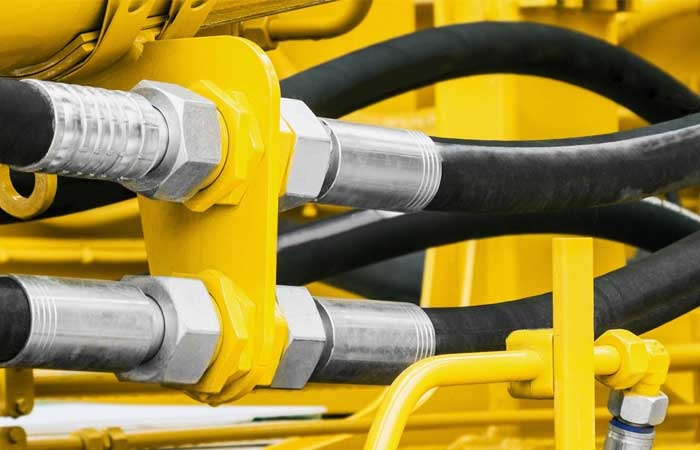
Power Under Pressure
India’s ambitious infrastructure projects, including highways, metro rail networks, and smart cities, are driving the demand for construction machinery equipped with hydraulic systems. As the government allocates substantial investments in infrastructure development, the need for reliable hydraulic hoses to power these machines is escalating.
With agriculture being a cornerstone of India’s economy, the mechanisation of farming processes is gaining momentum. Hydraulic hoses play a vital role in modern agricultural machinery such as tractors, harvesters, and irrigation systems, contributing to increased agricultural productivity and efficiency.
India's burgeoning manufacturing sector, coupled with the growing adoption of automation and industrial machinery, is fueling demand for hydraulic hoses in various industrial applications. From automotive manufacturing to material handling, hydraulic systems are integral to industrial processes, driving the need for high-performance hoses.
With safety and efficiency becoming paramount concerns in the Indian construction and industrial sectors, there is a growing emphasis on the use of high-quality hydraulic hoses that comply with international standards. Manufacturers and suppliers in the Indian market are responding by offering a wide range of certified hoses designed to meet stringent safety requirements.
Competitive landscape
In the highly competitive Indian hydraulic hose market, several domestic and international players vie for market share and customer loyalty. Leading multinational companies such as Parker Hannifin, Eaton Corporation, and Gates Corporation have established a strong presence in India, leveraging their extensive product portfolios, global expertise, and distribution networks to serve diverse industries.
At the same time, domestic players such as Polyhose India, Super Hoze Industries, and Indo-Maksson Automotive are making significant strides in the market, offering indigenous manufacturing capabilities, localised support, and competitive pricing.
The Indian hydraulic hose market is experiencing significant growth, fuelled by several key factors such as the expanding construction and manufacturing sectors, along with the introduction of advanced agricultural technologies. Additionally, a major driver for the industry is the growing demand for dredging services in both major and non-major ports across the country. The dredging sector's importance is further highlighted by recent efforts to promote local manufacturing through initiatives like Make in India and the government's focus on enhancing the Indian maritime sector.
The Indian market for hydraulic hose is segregated on the basis of product type and industry. Based on the product type, the market is further classified into articulated, reinforced, coiled, and other (corrugated). The reinforced segment is projected to have a considerable share owing to the growing application in various industries such as construction and mining. Based on the industry, the Indian hydraulic hose market is further segmented into agriculture, construction and mining, manufacturing, and others.
The requirement of hydraulic hoses for high-pressure hydraulic oil lines in agriculture, machine tool and construction industry are likely to contribute to the growth of the market.
Emerging trends
Recognising the diverse needs of Indian industries and applications, leading hydraulic hose manufacturers are offering customised solutions tailored to local requirements. From specialised hose designs to localised production facilities, companies are adapting their offerings to cater to the unique demands of the Indian market.
The Indian hydraulic hose industry is witnessing a wave of technological advancements aimed at enhancing hose performance, durability, and efficiency. Innovations such as advanced materials, precision manufacturing techniques, and IoT-enabled monitoring systems are reshaping the landscape, enabling users to optimise hydraulic system performance and minimise downtime.
With increasing awareness of environmental sustainability, there is a growing demand for eco-friendly hydraulic hoses that minimise environmental impact. Manufacturers are investing in research and development to develop hoses made from renewable materials, as well as recyclable and biodegradable alternatives, to align with India's sustainability goals.
The adoption of e-commerce platforms and digitalisation initiatives is transforming the procurement process in the Indian hydraulic hose industry. Online marketplaces and digital catalogs offer customers greater convenience, transparency, and access to a wide range of products, driving efficiency and streamlining supply chain operations.
Safety
Lack of awareness among customers about a hose assembly may lead to premature failure. 'The awareness of the importance of safety in hydraulic hoses has increased significantly and customers are preferring quality products.
Most of the leakages happen at the interface of the hose and coupling, but some people resist changing, preferring local fittings available in the market at cheaper prices over a validated coupling from the manufacturer. Gates offers a high-performance and safe hose and coupling system, which we insist our customers buy to get maximum output and to reduce downtime. It is always preferable to buy fittings directly from hose manufacturers, which are manufactured and validated as per industry standards for leak-free performance.
Conclusion
As India propels itself towards a future of economic growth and industrial progress, the hydraulic hose industry stands at the forefront, powering the nation's infrastructure aspirations and industrial ambitions. With a keen focus on innovation, customisation, and sustainability, the Indian hydraulic hose market is poised for continued growth and evolution. By embracing emerging trends, harnessing technological advancements, and fostering collaboration between industry stakeholders, India's hydraulic hose industry can chart a course towards a more resilient, efficient, and sustainable future.


 +91-22-24193000
+91-22-24193000 Subscriber@ASAPPinfoGlobal.com
Subscriber@ASAPPinfoGlobal.com